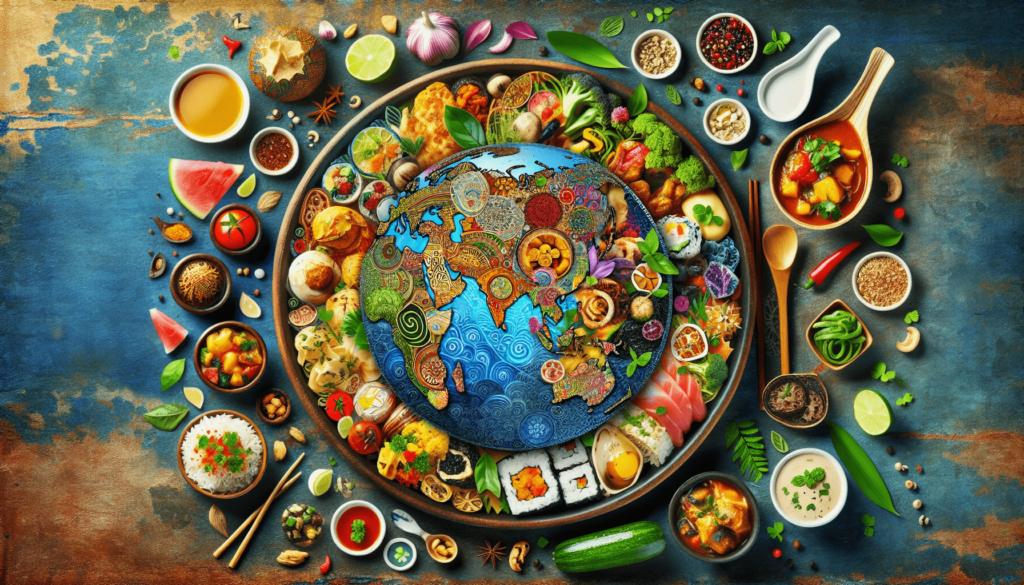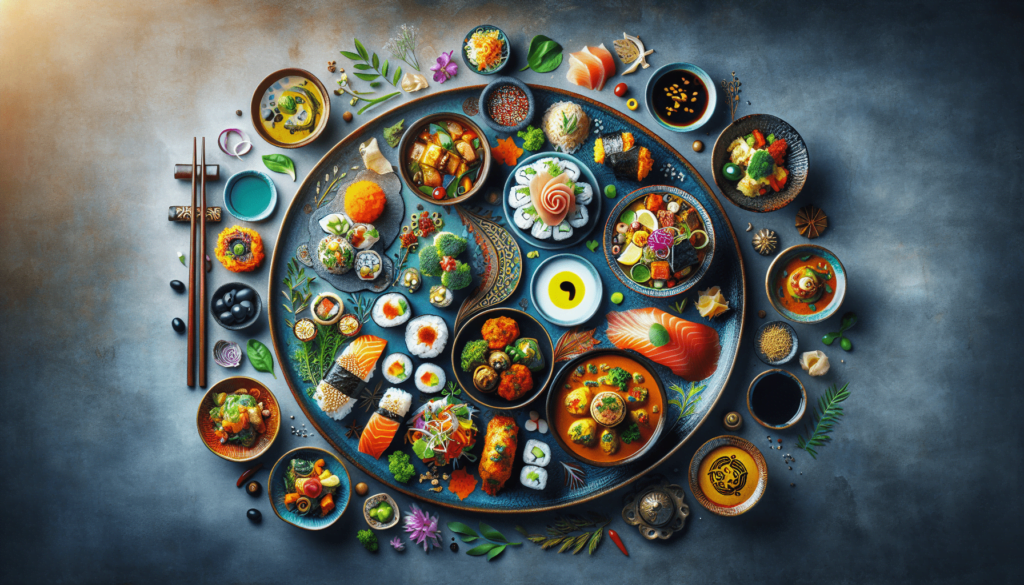In “Savoring Global Flavors: Foodie Footprints Across Continents,” you’re about to embark on a culinary journey that spans continents and cultures, offering a delightful exploration of the world’s most tantalizing dishes. Imagine savoring the rich, spicy aromas of Indian curries, the delicate, intricate flavors of Japanese sushi, and the robust, hearty tastes of Italian pastas.
This article guides you through the fascinating history and contemporary trends of global cuisine, highlighting how local ingredients and traditional cooking methods create unique, mouth-watering experiences. You’ll also delve into captivating case studies and insightful comparisons of different culinary traditions, providing a well-rounded understanding of how our tastes and preferences are influenced by and contribute to diverse food cultures. Whether you’re a seasoned gourmet or an enthusiastic novice, this article will leave you inspired to broaden your palate and appreciate the stories behind each delicious bite worldwide.
Have you ever wondered just how many flavors the world has to offer? The journey of exploring global cuisine is akin to embarking on an endless adventure, each bite telling a rich story of culture, history, and innovation. This article is your ticket to that culinary voyage, guiding you through diverse food landscapes across continents.

Table of Contents
Overview
Food is more than just sustenance; it is an integral part of cultural identity and heritage. As globalization blurs geographical boundaries, our curiosity about international flavors grows, making this a perfect time to explore global delicacies. Understanding and appreciating these varied cuisines not only tantalizes our taste buds but also fosters cultural connection and appreciation.
Thesis Statement
This article aims to delve into the rich tapestry of global cuisines by examining their historical contexts, current trends, and future directions. By savoring global flavors and leaving our foodie footprints across continents, we gain deeper insights into cultures around the world.
Historical Context
Food traditions have evolved dramatically over centuries, shaped by wars, trade, migration, and colonization. From the spice routes that connected the East to the West, to the Columbian Exchange that introduced new crops to different continents, our dining habits have been in a constant state of transformation.
For instance, the introduction of spices like cinnamon, black pepper, and cloves from Asia to Europe fundamentally altered European cuisines. Similarly, the migration of people brought ingredients like potatoes, tomatoes, and maize to new lands, transforming local dishes into what we recognize today.
Example: The Spice Trade’s Impact
The spice trade between Asia and Europe is a prime example of how food shaped history. Countries like India, China, and Indonesia were rich sources of spices that became highly coveted in Europe. This led to the establishment of trade routes and even played a part in the Age of Exploration, changing the world as we know it.
Savoring Global Flavors: Foodie Footprints Across Continents
Current Trends
Today, the globalization of food is a thriving phenomenon. Fusion cuisine, food tourism, and the farm-to-table movement are some of the major trends gaining momentum. These trends aim to bridge cultural gaps while promoting sustainability and local sourcing.
Fusion Cuisine
Fusion cuisine combines elements from different culinary traditions to create innovative dishes. Sushi burritos, Indian tacos, and Korean BBQ tacos are examples of how chefs are merging flavors and techniques from around the world.
Food Tourism
Food tourism, or culinary tourism, is another growing trend. Travelers are increasingly seeking out destinations known for their unique culinary experiences. Whether it’s street food in Bangkok, wine tasting in France, or pasta-making classes in Italy, food tourism offers a deeper, more immersive travel experience.
Farm-to-Table Movement
The farm-to-table movement emphasizes sourcing ingredients directly from local farms, promoting sustainability and freshness. This trend highlights the importance of understanding where our food comes from and encourages the support of local farmers.
Key Concepts and Definitions
To fully appreciate global cuisines, it’s essential to familiarize yourself with some key concepts and terms:
- Fusion Cuisine: A blend of culinary traditions from different cultures to create novel dishes.
- Farm-to-Table: A movement focusing on sourcing ingredients directly from local producers.
- Street Food: Easily accessible, ready-to-eat food sold by vendors in public spaces.
- Food Tourism: Traveling with the primary purpose of experiencing the food culture of a destination.
Understanding these terms will enhance your appreciation and comprehension as we delve deeper into the subject.

Detailed Exploration
Let’s break down the topic into specific areas and explore each one to gain a thorough understanding.
Europe: A Melting Pot of Flavors
European cuisine offers a diverse range of flavors, from the rich, buttery dishes of France to the hearty, comforting meals of Germany. Italy’s pasta and pizza have become global staples, while Spain’s tapas culture invites social dining. The continent’s varied climates and landscapes contribute to a wealth of culinary traditions.
Example: Italy’s Pasta and Pizza
Italy’s culinary influence is widespread, with pasta and pizza at the forefront. A plethora of pasta shapes, sauces, and regional variations make it endlessly fascinating. Naples is particularly famous for its traditional pizza, where the simplicity of ingredients—fresh dough, tomatoes, mozzarella, and basil—creates an iconic dish.
Asia: A Fusion of Tradition and Innovation
Asia offers an extraordinary culinary diversity. From the intricate sushi of Japan to the fiery curries of India, Asian cuisines are both traditional and innovative. Street food is a significant part of the culinary landscape, with bustling night markets and food stalls offering an array of flavorful delights.
Example: Japanese Sushi
Japanese sushi is a great example of how simplicity and precision can produce a culinary masterpiece. The use of fresh, high-quality ingredients, meticulous preparation techniques, and a focus on presentation make sushi not just a meal, but an art form.
Africa: Rich Heritage and Bold Flavors
African cuisine often goes unnoticed but is incredibly rich and diverse. Spices play a pivotal role, adding bold, vibrant flavors to dishes. From the stews and curries of West Africa to the tagines of North Africa, the continent’s culinary traditions are unique and varied.
Example: Moroccan Tagine
A Moroccan tagine is a slow-cooked stew, named after the earthenware pot in which it’s cooked. Ingredients like lamb, chicken, vegetables, dried fruits, and a blend of aromatic spices such as cinnamon, cumin, and saffron create a layered and complex flavor profile.
Americas: A Blend of Indigenous and Colonial Influences
The cuisines of North and South America are a combination of indigenous traditions and colonial influences. From the barbecue culture of the United States to Mexico’s vibrant street food, and the hearty, comforting dishes of Brazil, the Americas offer a rich culinary tapestry.
Example: Mexico’s Street Tacos
Mexican street tacos are a testament to the country’s vibrant food culture. Small, soft tortillas filled with a variety of meats, vegetables, and salsas make them infinitely customizable and delicious. They are a perfect representation of the country’s culinary diversity.
Comparison of Different Perspectives
The global appreciation for diverse cuisines brings up various perspectives. Some argue that globalization dilutes traditional culinary practices, while others believe it fosters evolution and innovation. Let’s explore these viewpoints.
Perspective 1: Preserving Tradition
Purists argue that traditional culinary practices should be preserved to maintain cultural integrity. They believe that the globalization of food can lead to the loss of authentic regional dishes and techniques.
Perspective 2: Embracing Change
On the other hand, some view the globalization of food as a positive force that encourages culinary innovation. They argue that fusion cuisine and international influences create new opportunities for culinary creativity and growth.
Impact Assessment
Both perspectives have merit. Preserving traditional culinary methods ensures cultural heritage and authenticity, while embracing change fosters innovation and diversity in the culinary world. The key lies in finding a balance between preserving tradition and embracing new influences.
Future Directions and Implications
As we look to the future, several trends and developments are likely to shape the culinary world. Technological advancements, sustainability efforts, and evolving consumer preferences will continue to influence how we eat and appreciate food.
Predictions
Sustainable Eating: With growing awareness of environmental issues, sustainable eating practices will become more prevalent. This includes reducing food waste, embracing plant-based diets, and supporting local and organic farming.
Technological Innovations: Technology will continue to play a significant role in the culinary world. From 3D-printed food to lab-grown meat, technological advancements will revolutionize how we think about food.
Global Culinary Exchange: Cultural exchange through food will only increase, with more people seeking out and experimenting with international flavors in their own kitchens.
Implications
The implications of these trends are significant. Sustainable eating can contribute to environmental conservation, while technological innovations can address food security issues. The global culinary exchange fosters cultural understanding and appreciation, bridging gaps and connecting people through the universal language of food.
Conclusion
Recap
Exploring global flavors is an enriching experience that goes beyond mere taste. It involves appreciating the historical contexts, current trends, and future directions of various cuisines. From the spice routes that shaped history to the digital age’s culinary innovations, our journey through food offers profound insights into different cultures.
Final Thought
So, the next time you savor a new dish, consider the rich tapestry of history, culture, and innovation that brought it to your plate. What stories are hidden within each bite, waiting to be discovered?
Engagement
We invite you to share your own culinary adventures and favorite international dishes in the comments below. Feel free to explore more resources and deepen your understanding of the world’s diverse culinary traditions.
Credible Sources
- Krondl, Michael. The Taste of Conquest: The Rise and Fall of the Three Great Cities of Spice. Ballantine Books, 2008.
- Davidson, Alan. The Oxford Companion to Food. Oxford University Press, 2014.
- Pollan, Michael. The Omnivore’s Dilemma: A Natural History of Four Meals. Penguin, 2006.
- Tropp, Barbara. The Modern Art of Chinese Cooking: Techniques and Recipes. William Morrow Cookbooks, 1992.
- Fernandez-Armesto, Felipe. Near a Thousand Tables: A History of Food. Free Press, 2003.
Take this knowledge with you and leave your own foodie footprints across continents, savoring the world one bite at a time.
Related site – Foodies: A Culinary Journey: Savoring Flavors with GatherInTheStops
